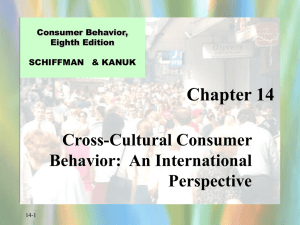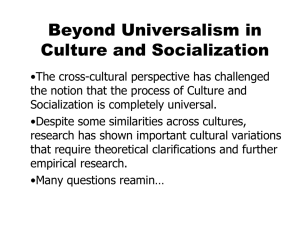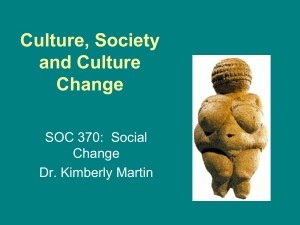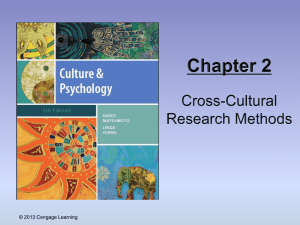Part A - The Resilience Research Centre
advertisement
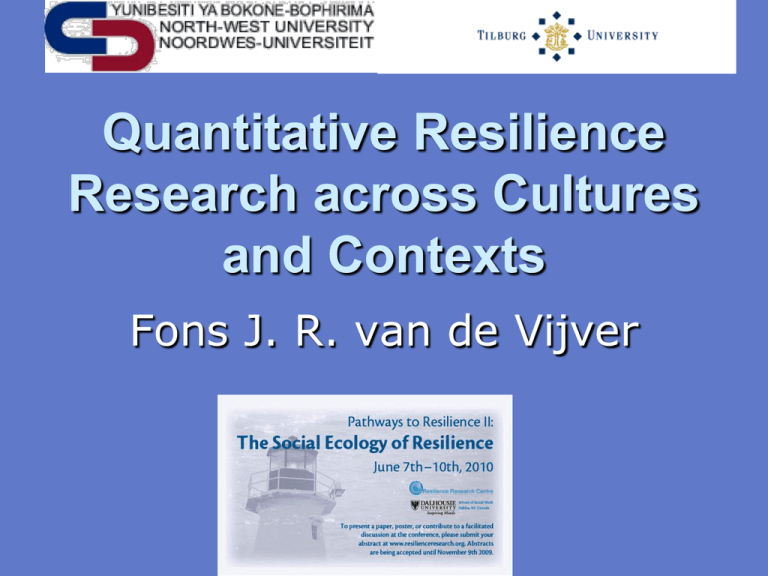
Quantitative Resilience Research across Cultures and Contexts Fons J. R. van de Vijver Outline 1. General introduction • Tertium comparationis Approaches: Absolutism/relativism/universalism • Identity of meaning 2. Common problems of cross-cultural studies (and their solutions) 3. Establishing similarity of meaning: • 3a. Bias and equivalence: Taxonomies • 3b. Examples 4. Acculturation • Concepts and Models / Assessment 5. Test adaptations • Concepts / Example General Introduction Conceptual core of cross-cultural studies • Aim is to compare constructs or scores Is resilience the same across the globe? Is Country A more/less resilient than Country B? • Comparison always implies some shared quality (tertium comparationis): If a comparison visualizes an action, state, quality, object, or a person by means of a parallel which is drawn to a different entity, the two things which are being compared do not necessarily have to be identical. However, they must possess at least one quality in common. This common quality has traditionally been referred to as tertium comparationis (Source: http://en.wikipedia.org/wiki/Tertium_comparationis). Views on the Relation between Resilience and Culture 1. Absolutism (“etic”) • Resilience refers to a universal set of characteristics that individuals use to cope with and thrive despite adversity 2. Relativism • Resilience refers to a concept (dealing with coping and thriving) that is universally applicable; however, its manifestations may differ across cultures • Example: Zimmerman & Brenner (2010, referring to Ungar, 2006) The conceptual foundation of resiliency theory can be applicable across cultures; the extent to which resources and assets are applied by youth in their experiences of adversity, however, may not be consistent across all contexts. 3. Relativism (“emic”) • Resilience refers to basic concept of coping and thriving; however, link between resilience and cultural context is so close that crosscultural comparisons of resilience are futile and superficial Choice between models is often made on an ideological basis However, more productive to see absolutism and relativism as extremes along a continuum Empirical studies possible of adequacy of these viewpoints Cross-cultural evidence is vital for determining which viewpoint holds for a particular measure/construct Part 2 What are common problems in comparative studies? •Central problem: Identity of meaning Common methodological problems of cross-cultural research and their solutions Problem 1 Cross cultural differences in scores cannot be interpreted due to rival hypotheses • Particularly salient in two-culture studies that do not consider contextual factors Solution: • Anticipate on rival hypotheses by including more cultures or measuring contextual factors Problem 2 Cross-cultural similarities and differences are visually (and not statistically) tested • A common example is the absence of a test of similarities of internal consistency coefficients Solution • Explicit tests of cross-cultural similarities and differences; e.g., simple test of similarity of independent reliabilities available Test of Independent Reliabilities 1 and 2: the reliabilities (usually Cronbach's of an instrument in two cultural groups. Statistic (1-12) follows an F distribution with N1 - 1 and N2 - 1 degrees of freedom (N1 and N2 are the sample sizes). Problem 3 Samples show confounding differences • Particularly salient in convenience sampling Solution: • Adaptation of study design and assessment of confounding differences Problem 4 Means of different cultural groups are compared without assessing the equivalence • Particularly salient when studying new instruments or working with cultures in which instrument has not been used Solution: • Assessment of structural and metric equivalence; assessment of structural equivalence/differential item functioning should be a routine part of analysis, similar to routine assessment of internal consistency Problem 5 Cultural characteristics are attributed to all individuals of that culture (ecological fallacy) • Particularly common in studies of individualism—collectivism Solution: • Awareness of distinction between individual-and culture-level characteristics • Assessment of relevant characteristics, such as individualism—collectivism, at individual level Problem 6 No check on quality of translation/ adaptation • Check is often not reported or procedure is poorly specified (e.g., translation back translation has been used, but results of procedure are not reported) Solution: • Awareness that translation back translation is not always the best possible method; other approaches, such as committee approach, may be more suitable • More detail in reports about translation/adaptation procedure Problem 7 Lack of rationale for selecting cultures • Convenience sampling of cultures is by far the most common procedure in cross-cultural psychology; most common comparison is between Japan and the US Solution: • Explain why the culture was chosen Problem 8 There is a verification bias in studies of common paradigms • Particularly salient in studies of individualism –collectivism Solution: • More critical appreciation of the boundaries of the construct, more focus on falsification Problem 9 There is a focus on the statistical significance of cross-cultural differences • In the first and two related problems: Implicit goal of cross-cultural psychology is not the establishment of cross-cultural differences Focus on significance detracts attention from effect sizes Solution: • Balanced treatment of similarities and differences; differences easier to interpret against a backdrop of similarities • More effect sizes should be reported, such as Cohen’s d and (partial) eta squares. Problem 10 Results are generalized to large populations, often complete populations of countries, although no probability sampling has been employed to recruit participants • Particularly salient in convenience sampling of participants (often student samples) Solution • More attention in reports for sampling frame and for consequences on external validity Part 3a Bias and equivalence: • Definitions of concepts • A framework (a) Bias and Equivalence Does the test measure the same attributes for all cultural groups? Can scores be compared across ethnic groups? Bias: Taxonomy What is internal bias? • General: dissimilarity of psychological meaning across cultural groups • Practical: when cross-cultural differences do not involve target construct measured by the test • Theoretical: a cross-cultural comparison is biased when observed cross-cultural differences (in structure or level) cannot be fully interpreted in terms of the domain of interest Taxonomy of Bias Type Source Construct bias Theoretical construct Method bias Measurement aspects (e.g., sample, test, administration) Specific item aspects (e.g., poor translation) Item bias Construct Bias Partial nonoverlap of behaviors defining construct • González Castro & Murray (2010): Criteria for resilience are based on studies with U.S. youth and adults, and one important cross-cultural issue involves how these criteria, as Westernized aspects of resilience, may or may not relate to resilience that is manifest in underdeveloped and/or nonWestern countries. • Definition of happiness in individualistic and collectivistic countries? Example: Uchida, Norasakkunkit and Kitayama (2004): Types and Sources of Method Bias Type Source Sample bias Confounding sample differences (e.g., education) Instrument bias Test characteristics (e.g., scoring of open end responses, response sets) Administration Procedural aspects (e.g., interviewer bias effects, lack of standardization of administration) Method bias tends to have a global influence on crosscultural score differences (e.g., increment due to social desirability) Item Bias (also known as differential item functioning, DIF) Informal description Differences in psychological meaning of stimuli, due to anomalies at item level More formal definition: An item of a scale (e.g., measuring anxiety) is said to be biased if persons with the same trait anxiety, but coming from different cultures, are not equally likely to endorse the item. Example of Biased Item 1 Mean score 0.8 0.6 Culture A Culture B 0.4 0.2 0 1 2 3 4 Total test score 5 6 Types of (un)biased items (b) Item with uniform bias 5 5 4 4 Mean score Mean score (a) Unbiased item 3 2 1 3 2 1 0 0 Very low Low Medium High Very low Very high Low Culture A Culture B (c) Item with non-uniform bias Very high Mean score 4 3 2 1 0 Culture B (d) Item with both uniform and nonuniform bias 5 5 Mean score High Score level Score level Culture A Medium 4 3 2 1 0 Very low Low Medium High Very high Very low Low Score level Culture A Culture B Medium High Score level Culture A Culture B Very high Analysis of Variance and Item Bias Item behavior examined per item We do not test for cultural differences, but we test whether scores are identical for persons from different groups with an equal proficiency Note: regression approach quite similar (illustrated later) Taxonomy of Equivalence Refers to level of comparability Is related to bias: Highest level of equivalence obtained for bias-free measurement Types of Equivalence Three types: •1. “Structural” or “functional equivalence” •2. “Metric equivalence” or “measurement unit equivalence” •3. “Scalar equivalence” or “full score equivalence” (a) “Structural” or “Functional Equivalence” Measurement of the same traits Various statistical tools available, e.g., • exploratory factor analysis (with target rotation) • confirmatory factor analysis • nomological networks (particularly relevant when items/questions are not identical across cultures) Qualitative equivalence can be firmly established (b) “Metric Equivalence”, “Measurement Unit Equivalence” Difference in offset of scales of cultural groups, equal measurement units Individual differences have a different meaning within and across cultures: no problems with offset in intra-cultural comparison, offset has to be added in cross-cultural comparison Statistical tool: structural equation modeling (confirmatory factor analysis) (c) “Scalar Equivalence” or “Full Score Equivalence” Complete comparability of scores, both within and across cultures; seamless transfer of scores across cultures Frequently taken as the aim of cross-cultural research Comparability and Equivalence Levels Equivalence Comparability Structural Underlying construct Metric Same plus score metric Scalar Same plus origin of scale Part 3b Establishing similarity of meaning • How to determine equivalence? • How to determine item bias? Many statistical procedures available for testing structural equivalence Common approach: • Apply dimensionality-reduction technique • Compare underlying dimensions across cultures • Similarity of underlying dimensions is criterion for similarity of meaning Testing Structural Equivalence: Exploratory Factor Analysis Two procedures explained •1. Pairwise comparisons Compare all cultures in a pairwise manner •2. “One to all” comparison Compare all cultures to a global, pooled solution • Characteristics of pairwise comparisons Strong point: much detail, all pairs compared Weak point: computationally cumbersome, difficult to integrate • Characteristics of pooled comparisons Strong point: maintains overview, integration Weak point: can conceal subgroups of countries Example Pairwise Data set: WISC-III administered in Canada and Netherlands/Flanders Sample age 6 7 8 9 10 11 12 13 14 15 16 male female Belgium/Neth Canada Belgium/Neth Canada 56 50 54 50 46 50 56 50 66 50 58 50 55 50 53 50 59 50 60 50 53 50 60 50 47 50 57 50 48 50 53 50 62 50 63 50 53 50 56 50 54 50 56 50 12 Subtests 1. 2. 3. 4. 5. 6. 7. 8. 9. 10. 11. 12. Picture Completion Information Coding Similarities Picture Arrangement Arithmetic Block Design Vocabulary Object Assembly Comprehension Symbol Search Digit Span Analysis Steps 1. 2. 3. Determine number of factors in combined sample Carry out factor analyses per group Compare factors across groups Note: analysis of scaled scores 1. Determining Number of Factors Scree Plot 6 5 4 3 Eigenvalue 2 1 0 1 2 3 4 Component Number 5 6 7 8 9 10 11 12 13 1. Determining Number of Factors Scree plot suggests the extraction of a single factor Literature: • Debate about 3 or 4 factors • Hierarchical model of correlated factors Here: 4 factors 2. Factor Analyses per group: Oblimin-Rotated Solution country = Belgium/Neth Scaled score for picture completion Scaled score for information Scaled score for coding Scaled score for similarities Scaled score for picture arrangement Scaled score for arithmetic Scaled score for block design Scaled score for vocabulary Scaled score for object assembly Scaled score for comprehension Scaled score for symbol search Scaled score for digit span Scaled score for mazes Component 1 0.15 0.79 -0.02 0.77 0.10 0.58 0.06 0.87 -0.05 0.78 -0.02 0.37 -0.10 2 -0.05 0.03 0.92 0.02 0.13 0.13 0.12 -0.03 0.00 -0.06 0.85 0.14 -0.07 3 -0.73 0.00 0.04 -0.10 -0.61 -0.10 -0.62 0.00 -0.76 -0.05 -0.10 0.17 -0.19 4 -0.16 0.07 -0.05 -0.06 -0.04 0.16 0.27 0.02 0.16 -0.11 -0.02 0.54 0.82 2. Factor Analyses per group: Oblimin-Rotated Solution country = Canada Scaled score for picture completion Scaled score for information Scaled score for coding Scaled score for similarities Scaled score for picture arrangement Scaled score for arithmetic Scaled score for block design Scaled score for vocabulary Scaled score for object assembly Scaled score for comprehension Scaled score for symbol search Scaled score for digit span Scaled score for mazes 1 0.38 0.86 -0.09 0.82 0.34 0.52 0.11 0.92 0.14 0.74 -0.01 0.31 -0.13 2 0.04 -0.09 0.94 0.00 0.26 0.13 0.27 -0.05 0.11 0.07 0.83 0.21 -0.11 3 -0.37 -0.02 0.10 -0.03 -0.15 -0.25 -0.62 0.07 -0.57 0.09 -0.07 -0.14 -0.88 4 -0.31 0.08 0.05 -0.04 -0.37 0.32 -0.09 0.03 -0.30 -0.01 0.03 0.69 0.19 3. Compare Factors across Groups Rotate one solution to the other • Target rotations to deal with rotational freedom in factor analysis Evaluation by means of Tucker’s phi (factor congruence coefficient): • similarity of factors up to multiplying (positive) constant (correct for differences in eigenvalues across cultures) 3. Compare Factors across Groups Formula (x and y are loadings after target rotation of one to the other): 2 2 xi yi xi yi 3. Compare Factors across Groups original sum multiplication -0.2 0.2 -0.4 0.2 0.6 0.4 0.3 0.7 0.6 0.4 0.8 0.8 phi 0.858474 1 3. Compare Factors across Groups Values above .90 are usually considered to be adequate and values above .95 to be excellent Such high values point to similarity of factors structural equivalence 3. Compare Factors across Groups Dedicated software needed to compute Tucker’s phi SPSS routine available pictcomp informat coding similari pictarra arithmet blockdes vocabula objecass comprehe symbsear digitspa mazes FACTOR LOADINGS AFTER TARGET ROTATION 0.31 0.07 -0.38 -0.59 0.77 0.02 0.03 0.21 -0.06 0.9 0.13 0.12 0.78 0.03 0.04 0.05 0.22 0.22 -0.38 -0.4 0.57 0.14 -0.12 0.17 0.16 0.2 -0.6 -0.2 0.85 -0.04 0.06 0.17 0.09 0.12 -0.64 -0.42 0.78 -0.05 0.11 0.03 -0.03 0.86 0 0.04 0.28 0.08 -0.23 0.58 -0.12 -0.08 -0.73 0.41 Belg./Neth. rotated DIFFERENCE -0.07 -0.09 0.04 -0.05 -0.12 0.05 0.05 -0.07 -0.05 0.04 -0.02 -0.04 0.01 IN LOADINGS AFTER TARGET ROTATION 0.04 -0.01 -0.28 0.11 0.05 0.13 -0.04 0.03 0.07 0.03 0.08 0.09 -0.03 -0.22 -0.03 0 0.12 -0.14 -0.06 0.01 -0.11 0.02 -0.01 0.15 0 -0.07 -0.12 -0.12 0.02 0.04 0.03 0.07 0.01 -0.14 -0.09 -0.11 0.02 0.15 0.22 PROPORTIONALITY COEFFICIENT per Factor: .99 .98 .97 .91 Conclusion Strong evidence for similarity of first two factors Less convincing for third and fourth factor 56 Example “One to All” Steps in analysis: • 1. Exploratory factor analysis on the total data set; Two procedures (note: correct for mean differences between groups): • “quick and dirty”: standardize scores per cultural groups and factor analyze the standardized scores • more adequate solution: compute the weighted average of the covariance matrices of the cultural groups (weight by sample size) this factor analysis provides the “pooled solution” “One-to-all” procedure 2. Carry out a factor analysis in each cultural group 3. Compute agreement of the pooled solution and each of the country solutions Source: Van de Vijver, F.J.R. & Poortinga, Y.H. (2002). Structural Equivalence in Multilevel Research. Journal of Cross-Cultural Psychology. Example 1990-1991 World Values Survey (Inglehart, 1993, 1997) 47,871 respondents from the following 39 “regions” (number of respondents in parentheses): Austria (1355), Belarus (912), Belgium (2318), Brazil (1672), Bulgaria (877), Canada (1545), Chile (1368), China (960), (the former) Czechoslovakia (1384), Denmark (892), (the former) East Germany (1226), Estonia (864), Finland (416), France (902), Hungary (886), Iceland (659), India (2150), Ireland (976), Italy (1810), Japan (655), Latvia (720), Lithuania (847), Mexico (1193), Moscow (894), Netherlands (935), Nigeria (954), Northern Ireland (283), Norway (1111), Poland (850), Portugal (976), Russia (1642), South Africa (2480), South Korea (1210), Spain (3408), Sweden (901), Turkey (886), United Kingdom (1356), United States (1688), and (the former) West Germany (1710). Instrument Item Dimension Making sure this country has strong Materialism defense forces Seeing that people have more to say Postmaterialism about how things are done at their jobs and in their communities Trying to make our cities and countryside Postmaterialism more beautiful Maintaining order in the nation Materialism Giving people more to say in important Postmaterialism government decisions Protecting freedom of speech Postmaterialism A stable economy Materialism Progress toward a less impersonal and Postmaterialism more humane society Progress toward a society in which ideas count more than money Postmaterialism Pooled solution Item Defense Within -.30 Democracy1 .56 Cities .02 Order -.67 Democracy2 .57 Free speech .31 Econ. Stab. -.63 Humane .54 Ideas .43 Eigenvalue (percentage explained) 2.14 (23.9%) (Sign of loadings in line with expectation) Stem-and-Leaf Display of Agreement Pooled Loadings and Factor Loadings per Country Stem Leaf .99 01346 .98 00012566667 .97 56789 .96 36 .95 068 .94 227 .93 249 .92 4 .91 8 .90 348 .89 1 .57 (Extreme) Each leaf represents one observation (country) Correlations of GNP and the Loadings per Region on the Postmaterialism Scale Item Correlation Defense .06 Democracy1 -.26 Cities .51** Order .59*** Democracy2 -.60*** Free speech -.09 Econ. Stab. -.50** Humane .52*** Ideas .47** Conclusion: Postmaterialism concept more salient in more affluent countries Metric Equivalence at Scale Level: Structural Equation Modeling Difference with Exploratory Factor Analyses Starts from covariance matrices • Use metric information More parameters tested for cross-cultural similarity; examples • • • • Factor loadings Factor correlations/covariances Error component of latent variables Error component of observed variables Enables the testing of a hierarchy of models Example of AMOS Model tested: one factor of verbal comprehension factor in two countries (Belgium/Netherlands and Canada) Models tested: • Identical factor loadings across countries • Free factor loadings • Idem with a correlated error For diagram and output: see AMOS files Basic Model e1 1 INFORMAT 1 e2 e3 e4 e5 1 1 1 1 SIMILARI ARITHMET VOCABULA COMPREHE intelligence 1 e6 Use of multiple group option Measurement weights: regression weights in the measurement part of the model. In the case of a factor analysis model, these are the "factor loadings". Structural residuals: variances and covariances of residual (error) variables in the structural part of the model. Measurement residuals: variances and covariances of residual (error) variables in the measurement part of the model. AMOS model e1 1 INFORMAT 1 e2 1 a SIMILARI b e3 1 ARITHMET c intelligence 1 d e4 e5 1 1 VOCABULA COMPREHE Measurement weights e6 AMOS model e1 1 INFORMAT 1 e2 1 a SIMILARI b e3 1 ARITHMET c intelligence 1 e6 d e4 e5 1 1 VOCABULA COMPREHE Structural residuals AMOS model e1 1 INFORMAT 1 e2 1 a SIMILARI b e3 1 ARITHMET c intelligence 1 d e4 e5 1 1 VOCABULA COMPREHE Measurement residuals e6 BelgNeth Unconstrained Estimate S.E. C.R. P Label Regression Weights: (Canada - Unconstrained) COMPREHE <--- intelligence .952 .042 22.661 *** a1_1 VOCABULA <--- intelligence 1.144 .043 26.736 *** a2_1 ARITHMET <--- intelligence .801 .036 22.415 *** a3_1 SIMILARI <--- intelligence 1.031 .042 24.720 *** a4_1 INFORMAT <--- intelligence 1.000 Estimate S.E. C.R. Canada P Label COMPREHE <--- intelligence .874 .040 21.770 *** a1_2 VOCABULA <--- intelligence 1.158 .041 28.323 *** a2_2 ARITHMET <--- intelligence .780 .038 20.796 *** a3_2 SIMILARI <--- intelligence 1.056 .039 26.886 *** a4_2 INFORMAT <--- intelligence 1.000 CMIN Model Unconstrained Measurement weights Structural residuals Measurement residuals Saturated model Independence model NPAR 22 18 CMIN DF P CMIN/DF 47.982 8 .000 5.998 51.793 12 .000 4.316 17 53.049 13 .000 11 66.732 19 .000 30 .000 0 10 5084.104 20 .000 4.081 3.512 254.205 RMR, GFI Model Unconstrained Measurement weights RMR .157 .185 GFI AGFI PGFI .992 .970 .265 .991 .978 .397 Structural residuals .241 .991 Measurement residuals .227 .988 Saturated model .000 1.000 Independence model 4.034 .450 .979 .982 .429 .626 .175 .300 RMSEA Model Unconstrained Measurement weights Structural residuals Measurement residuals Independence model RMSEA LO 90 HI 90 PCLOSE .046 .034 .059 .658 .038 .028 .049 .969 .036 .033 .330 .027 .025 .322 .047 .042 .338 .985 1.000 .000 Nested Model Comparisons Assuming model Unconstrained to be correct: Model DF CMIN P Measurement weights Structural residuals Measurement residuals 4 5 11 3.811 5.067 18.750 .432 .408 .066 NFI Delta-1 .001 .001 .004 IFI Delta-2 .001 .001 .004 RFI rho-1 -.007 -.008 -.010 TLI rho2 -.007 -.008 -.010 NFI Delta-1 .000 .003 IFI Delta-2 .000 .003 RFI rho-1 -.001 -.003 TLI rho2 -.001 -.003 NFI Delta-1 .003 IFI Delta-2 .003 RFI rho-1 -.002 TLI rho2 -.002 Assuming model Measurement weights to be correct: Model Structural residuals Measurement residuals DF CMIN P 1 7 1.256 14.939 .262 .037 Assuming model Structural residuals to be correct: Model Measurement residuals DF CMIN P 6 13.683 .033 Metric Equivalence at Item Level: Item Bias Analysis/ Differential Item Functioning (DIF) Hundreds of statistical procedures available Assumption: • Equal observed scores on global instrument (scale) in different cultures have the same meaning Almost all techniques start from unidimensional scales Procedures test whether, given equal total scores, patterns of observed scores are the same across cultures Often applied procedures • ANOVA (example follows) • Item Response Theory • (in education) Mantel-Haenszel (equivalent to testing applicability of Rasch model) How to Determine Item Bias? Analysis of variance INPUT: a data matrix with intervallevel dependent variables (e.g., Likert-scale), one variable indicating culture. Step 1: Compute Total Score Compute total test score (or mean item score) (so, a unifactorial scale is assumed). COMPUTE sumscore = i_acad_1 + i_cult_1 + i_groo_1 + i_infl_1 + i_inte_1 + i_like_1 + i_look_1 . EXECUTE . Step 2: Determine Cutoffs (here three groups; percentiles 33 and 67). EXAMINE VARIABLES=sumscore /PLOT BOXPLOT STEMLEAF /COMPARE GROUP /PERCENTILES(33, 67) HAVERAGE /STATISTICS DESCRIPTIVES /CINTERVAL 95 /MISSING LISTWISE /NOTOTAL. OR FREQUENCIES VARIABLES=sumscore /NTILES= 3 /ORDER= ANALYSIS . Step 3: Compute Level RECODE sumscore (Lowest thru 48=1) (49 thru 57=2) (58 thru Highest=3) (ELSE=SYSMIS) INTO level . VARIABLE LABELS level 'Score level'. EXECUTE . Step 4: Carry out ANOVAs UNIANOVA i_acad_1 i_cult_1 i_groo_1 i_infl_1 i_inte_1 i_like_1 i_look_1 BY group level /METHOD = SSTYPE(3) /INTERCEPT = INCLUDE /PRINT = DESCRIPTIVE ETASQ /CRITERIA = ALPHA(.05) /DESIGN = group level group*level . Significant main effect of level: irrelevant Significant main effect of culture: uniform bias Significant interaction between culture and level: nonuniform bias NOTE: in large samples effect sizes can be used (eta squared > .06: Cohen’s medium effect size) Regression DESCRIPTIVES VARIABLES=sumscore cult /STATISTICS=MEAN STDDEV MIN MAX. * compute predictor values for these new variables. compute dev_mean=sumscore-52.6091. compute dev_cult=cult-1.4473. EXECUTE . compute interaction = dev_mean*dev_cult. EXECUTE . REGRESSION /MISSING LISTWISE /STATISTICS COEFF OUTS R ANOVA /CRITERIA=PIN(.05) POUT(.10) /NOORIGIN /DEPENDENT i_acad_1 /METHOD=ENTER sumscore /METHOD=ENTER cult /METHOD=ENTER interaction. Part 4. Acculturation Definition: Acculturation refers to changes that take place as a result of continuous firsthand contact between individuals of different cultural origins (Redfield, Linton, & Herskovits, 1936). Psychological acculturation refers to psychological aspects of process • Acculturation research traditions: Stress and coping Social learning Social cognition (more recent) Framework of Acculturation: Acculturation Variables Acculturation Conditions Acculturation Orientations Acculturation Outcomes Characteristics of the receiving society (e.g., discrimination, opportunity structures) Cultural adoption Psychological well-being (psychological distress, mood states, feelings of acceptance, and satisfaction) Sociocultural competence in ethnic culture (interaction with conationals, maintenance of culturally appropriate skills and behaviors) Sociocultural competence in mainstream culture (interaction with hosts, acquisition of culturally appropriate skills and behaviors) Characteristics of the society of origin (objective, perceived) Characteristics of the immigrant group (objective, perceived) Personal characteristics Cultural maintenance Features Compare S-O-R model Mediation model with feedback loops • Feedback almost never studied • Causality usually inferred (so, some arbitrariness) Implicit scheme • distal—proximal—output Term adaptation used in literature to refer to adjustment/output • Problem: adaptation can refer to both product and process Resilience-Related Pathways for Immigrants (González Castro & Murray, 2010) Studies of Acculturation Conditions Personality often studied • MPQ, Big Five Usually: extraversion +, neuroticism – Intelligence not studied Multiculturalism policies presumably unrelated to acculturation outcomes in Western societies • ESS (Schalk-Soekar et al., 2007) • ICSEY (Berry et al., 2006) 2 examples • Perceived acculturation context • Perceived cultural distance Structure of Perceived Environment Mainstream context: Minority context: Role of (perceived) cultural distance Dimensionality of Cultural Distance Psychological measures of distance (perceived cultural distance) load on a single factor • Note: models of cross-cultural distance models tend to be multidimensional (e.g., Hofstede) Acculturation Orientations Notes on terminology: 1. Various terms used, e.g., Strategies, styles, orientations 2. Adaptation usually reserved for output/adjustment; here: adoption, adopting in original formulation: does the immigrant want to establish relationships with new culture? Problem: Narrow conceptualization 102 Cultural maintenance • maintaining characteristics of own (heritage) culture Cultural adoption • adopting characteristics of the culture of the society of settlement Acculturation Models Unidimensional model Cultural maintenance Bidimensional model Cultural maintenance Cultural adoption Cultural adoption Berry’s Bidimensional Model Yes Separation Integration Marginalization Assimilation Cultural maintenanc e? No No Yes Cultural adoption? Features Correlations of dimensions often vary • Conceptually independent • Empirically often negatively related Dimensions or orientations more important? • Methodologically: dimensions often easier to deal with • Conceptually: orientations prevail Note that integration refers to biculturalism in psychology and to sociocultural outcomes in sociology (a well integrated immigrant is a person who speaks the mainstream language, has a paid job, etc.) Fusion Model New culture Cultural maintenance Cultural adoption Domain Specificity •Conceptually domains independent •Empirically not always the case •Will depend on a host of factors, such as cultural distance, perceived pressure to assimilate, … •Often slightly negative correlations •Example: we found a clear negative corelation in the evaluations of Dutch and Turkish culture in a group of Turkish-Dutch Assessment of Acculturation: Recurrent Problems •Acculturation variables (conditions, orientations, and outcomes) are mixed •Reliance on ‘Proxy’ measures of acculturation, such as length of stay (poor validity) •Reliance on single-index measures (do not fully account for construct) Assessment of Acculturation: Recurrent Problems (cont’d) Measure of only adoption dimension, not of maintenance dimension Acculturation aspects (e.g., cognition, values, attitudes) are often combined. • Sound and meaningful? No psychometric properties reported Often emphasis on actual behavior and language proficiency • Measures often assess sociocultural outcomes that are used to predict other outcomes (e.g., school performance) Measure of only adoption dimension, not of maintenance dimension Outcomes Focus on two kinds of outcomes • Psychological adjustment (stress & coping) • Sociocultural adjustment (social learning) Almost no studies of cultural maintenance • This lack of balance absent in sociolinguistics where both acquisition of mainstream and loss of ethnic languages is studied • This lack of balance is also absent in study of acculturation orientations Measurement Methods Unidimensional model: (1) One-statement method (more - less) Bidimensional model: (2) Two-statement method (maintenance; adoption) (3) Four-statement method (acculturation strategies) (1) One-Statement Method Example item (1 statement for 1 domain) I find it important to have only Turkish friends. more Turkish than Dutch friends. as many Turkish as Dutch friends. more Dutch than Turkish friends. only Dutch friends. no Dutch and no Turkish friends. Advantages Short(est) questionnaire • Problem One dimension? Heritage Mainstream (1) One-Statement Method Research findings Domain specificity (public, private components) Turkish private public Recommendation This method is often quite useful in practice, despite conceptual problems Take domains into consideration 115 Dutch (2) Two-Statement Method Example (domain friends) I think it is important to have Dutch friends. 1 2 3 4 5 6 7 I think it is important to have Turkish friends. 1 2 3 4 5 6 7 Advantages The two dimensions are measured independently Items are not complex Questionnaire is still short Disadvantages/questions Are the two dimensions really independent? How to define the four acculturation orientations? How to Define the Four Acculturation Orientations? Sample-dependent coding: • Mean or (more common) median split Advantage: optimal spread of participants across orientations Disadvantage: validity can be problematic in groups with a shared preference (often the case for integration) How to Define the Four Acculturation Orientations? (cont’d) • Response scale-dependent coding – Midpoint split (average scores above or below midpoint of scale) • Advantage: face validity • Disadvantage: what to do when scale has even number of anchors? Solutions such as random split or allocating these to a single group have an unavoidable arbitrariness (2) Two-Statement Method Results • Possible method factor, e.g., all maintenance items together • Domain dependence: public domain (Tu, Du) private Dutch domain private Turkish domain • Domain dependence does not always show up as separate factors (usually based on differences in mean scores) Potential problem: • Two scores are sometimes converted to four orientations (e.g., distance method), which introduces dependencies in the data Recommendation This method can be used Take domains into consideration Acculturation Strategies 7 (1,7) Separation 6 (7,7) Integration Private Public 5 Cultural maintenance (Tu) 4 3 2 1 Marginalization (1,1) 1 2 3 Assimilation (7,1) 4 5 6 Cultural adoption (Du) 7 Summary of Results Results of the ‘one-statement’ and the ‘two-statement’ measurement methods: domain specificity Turkish Private Dutch Public 7 (1,7) Separation 6 (7,7) Integration Private Cultural Public 5 maintenance 4 (Turkish) 3 2 Marginalization 1 (1,1) 1 2 3 Assimilation (7,1) 4 5 6 7 Cultural adoption (Dutch) (3) Four-Statement Method Example item (4 items for 1 domain) (Int) I find it important to have Dutch friends and 1 2 3 4 5 I find it also important to have Turkish friends. (Sep) I find it not important to have Dutch friends but I find it important to have Turkish friends. 1 2 3 4 5 Advantage The four strategies are measured independently Disadvantages (questions) Complex items (see Marginalization) Questionnaire is long (per domain 4 questions) Factors and (independent) dimensions? (3) Four-Statement Method Research findings Bipolar unidimensional structure (-) Integration (+) A S M 80-85% of our immigrant Dutch samples prefer integration (one score) Advantages Method is broad Measure integration with more details Summary of Results Measurement methods Results Four-statement Insufficient discrimination: integration vs not-integration One-statement Discrimination between public and private domains Two-statement More detailed information within domains Two-statement method often works best. Questions to consider when choosing/designing an instrument 1. The clear formulation of research goals and choice of acculturation variables. What is the role of acculturation in the study? Antecedent, mediating/moderating, or outcome variable 2. Which acculturation aspects are dealt with? • knowledge, values, attitudes, or behavior 3. The choice of research methodology (how to study?) • “Soft” or “hard” measures • Self-reports, observations, … 4. The choice of a measurement method (how to assess acculturation?) • Orientations: one-, two-, and fourstatement method • Perceived or actual environmental conditions Multilevel issues may be involved when both individual and contextual variables are considered 5. The choice of life domains and situations to be dealt with in the items in which domains and situation to assess? 6. Choice of item wording. • Questionnaires often in second language • Use simple language An Empirical Study Methods (dimensions) of acculturation (1) One-statement method (2) Two-statement method (3) Four-statement method Domain(s) of acculturation Private domains (celebrations, child-rearing) Public domains (language, education, living) Participants 293 Turkish-Dutch adolescents Gender: 144 female and 149 male Generation: 15 first and 278 second generations Age: 11 - 19 years, M = 14.67 (SD = 1.69) Education: Secondary School Instrument and procedure (1) 15 items on 15 domains (7 private and 8 public) (2) 30 items on 15 domains (7 private and 8 public) (3) 36 items on 9 domains (5 private and 4 public) One-item method Public domain .26# -.81 One-item method Private domain .48$ .54 A Public C -.80 domain C U Two-item method Turkish culture Private domain -.26# .88$ L .55$ T Two-item method Dutch culture Public domain U R -.88$ .67 ## A .75 T I O N Two-item method Turkish culture Public domain -.85 Private Two-item method Dutch culture Private domain -.70 .69 M # E .67$ A S .43 U .68 .24 Two-item measurement method .65# R E M E Four-item method Integration Private domain Four-item method Separartion Public domain T .89$ Four-item method Separation 134 Private domain .96$ .31 -.32 # .32 .12# N Four-item method Integration Public domain domain One-item measurement method -.06 Four-item measurement method Summary of Results Measurement methods of acculturation One- and two-statement methods: no significant influences of measurement on outcome Four-statement method: the largest influence on outcome Domain specificity Distinct but interrelated positive relationship between private and public domains


